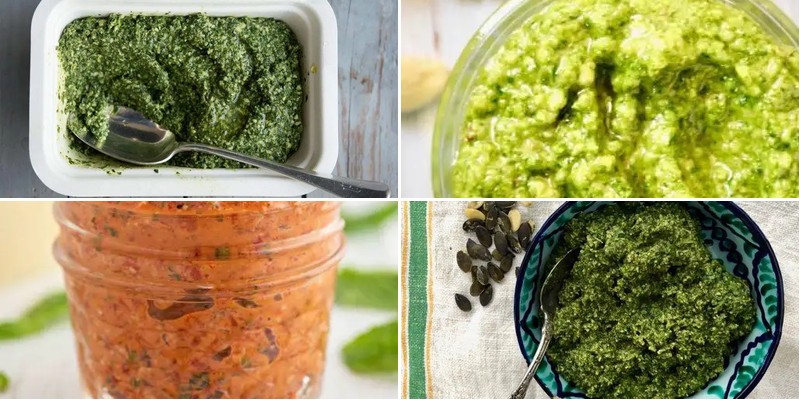Who says pesto has to stick to the classic basil and pine nut combo? We’re shaking things up with 20 creative twists that’ll transform your quick dinners and seasonal favorites. From nut-free alternatives to vibrant veggie versions, get ready to discover pestos that’ll become your new kitchen staples. Let’s dive into these flavorful upgrades that’ll make your meals anything but ordinary!
Spinach and Walnut Pesto
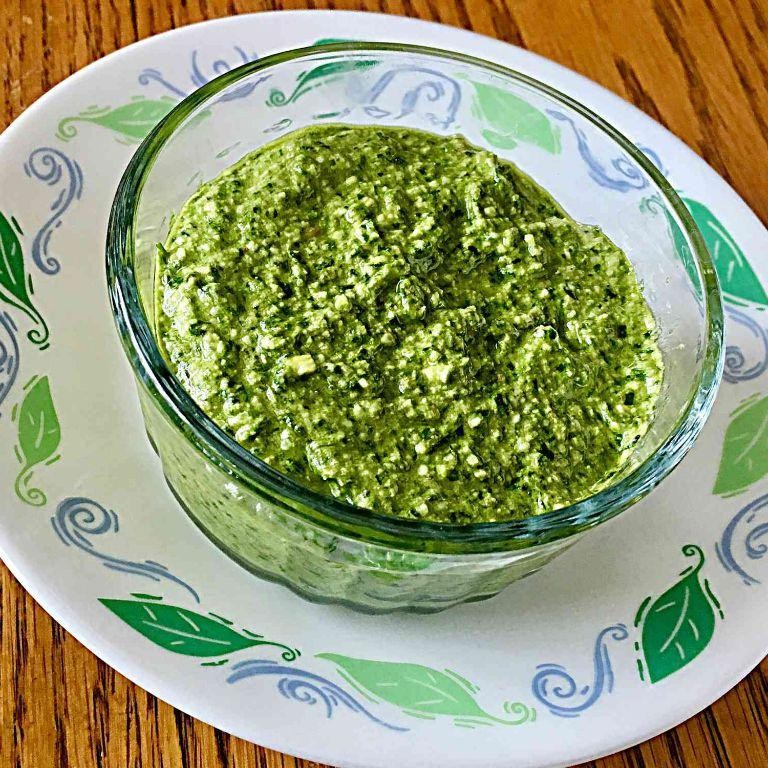
Just yesterday, as golden October light filtered through my kitchen window, I found myself craving something that felt both nourishing and nostalgic—a pesto that would capture this gentle seasonal shift in a jar. Joyfully simple yet deeply satisfying, this spinach and walnut version came together like an old friend stopping by for tea.
4
servings15
minutes10
minutesIngredients
– 2 cups fresh baby spinach leaves, vibrant and tender
– 1/2 cup raw walnut halves, lightly toasted and fragrant
– 1/3 cup rich extra virgin olive oil
– 1/4 cup finely grated Parmesan cheese, aged and nutty
– 2 cloves fresh garlic, peeled and minced
– 1 tablespoon freshly squeezed lemon juice, bright and zesty
– 1/2 teaspoon coarse sea salt, mineral-rich
– 1/4 teaspoon cracked black pepper, freshly ground
Instructions
1. Preheat your oven to 350°F and spread the raw walnut halves in a single layer on a small baking sheet.
2. Toast the walnuts for 8-10 minutes until golden brown and fragrant, stirring halfway through to prevent burning.
3. Allow the toasted walnuts to cool completely on the baking sheet for about 15 minutes—this prevents them from turning bitter when blended.
4. Combine the cooled walnuts, fresh baby spinach leaves, minced garlic, grated Parmesan, lemon juice, sea salt, and black pepper in a food processor bowl.
5. Pulse the mixture 5-7 times in 2-second bursts until coarsely chopped, scraping down the sides with a spatula between pulses.
6. With the food processor running on low speed, slowly drizzle in the extra virgin olive oil through the feed tube over 30 seconds until a coarse paste forms.
7. Stop processing once the pesto reaches your desired consistency—some texture remaining makes it wonderfully rustic.
8. Transfer the finished pesto to an airtight container, pressing plastic wrap directly against the surface to prevent oxidation.
Freshly made, this pesto carries the earthy depth of walnuts balanced by spinach’s gentle green notes, creating a sauce that clings beautifully to pasta or spreads thickly on crusty bread. For a lovely variation, try swirling it into warm white bean soup or dolloping over roasted salmon fillets—each spoonful feels like autumn captured in a bowl.
Kale and Almond Pesto

Beneath the gentle hum of the kitchen, there’s a quiet kind of magic in making something from scratch, a simple ritual of transforming a handful of humble ingredients into a vibrant, emerald-green pesto that feels both nourishing and deeply comforting. It’s a small act of care, a way to capture the fresh, earthy essence of the season in a jar.
2
servings15
minutes10
minutesIngredients
– 4 cups of tightly packed, fresh curly kale leaves, stems removed
– 1/2 cup of raw, unsalted almonds with their papery skins
– 2 cloves of fragrant, fresh garlic, peeled
– 1/2 cup of rich, golden extra virgin olive oil
– 1/4 cup of finely grated, sharp Parmesan cheese
– 2 tablespoons of freshly squeezed lemon juice, bright and tangy
– 1/2 teaspoon of flaky sea salt
Instructions
1. Preheat your oven to 350°F.
2. Spread the raw, unsalted almonds in a single layer on a small, dry baking sheet.
3. Toast the almonds in the preheated oven for 8-10 minutes, until they are fragrant and have taken on a light golden color, then set them aside to cool completely. (Tip: Toasting the almonds unlocks a deeper, nuttier flavor that forms the backbone of the pesto.)
4. Wash the fresh curly kale leaves thoroughly and pat them completely dry with a clean kitchen towel.
5. Use your fingers to strip the kale leaves away from their tough central stems, discarding the stems.
6. Add the cooled, toasted almonds and the peeled garlic cloves to the bowl of a food processor.
7. Pulse the food processor 8-10 times, until the almonds and garlic are broken down into a coarse, gravel-like texture.
8. Add the prepared, dry kale leaves, the finely grated Parmesan cheese, the freshly squeezed lemon juice, and the flaky sea salt to the food processor.
9. Secure the lid on the food processor and begin to pulse the mixture, scraping down the sides with a spatula as needed.
10. With the food processor running on low speed, slowly drizzle in the golden extra virgin olive oil through the feed tube until the pesto is mostly smooth but still has a bit of pleasant texture. (Tip: Slowly streaming in the oil while the processor is running helps it emulsify properly, creating a cohesive, creamy sauce.)
11. Taste the pesto and adjust the seasoning only if necessary, then transfer it to an airtight container. (Tip: For the brightest green color, press a piece of plastic wrap directly onto the surface of the pesto before sealing the container to limit its exposure to air.)
Embodying a beautiful balance, this pesto is wonderfully creamy yet textured, with the earthy depth of kale softened by the toasty, rich almonds. The sharp Parmesan and bright lemon lift everything, making it far more than just a pasta sauce. Try it swirled into warm grain bowls, as a vibrant spread for sandwiches, or even as a bold topping for grilled chicken or fish.
Sun-Dried Tomato Pesto
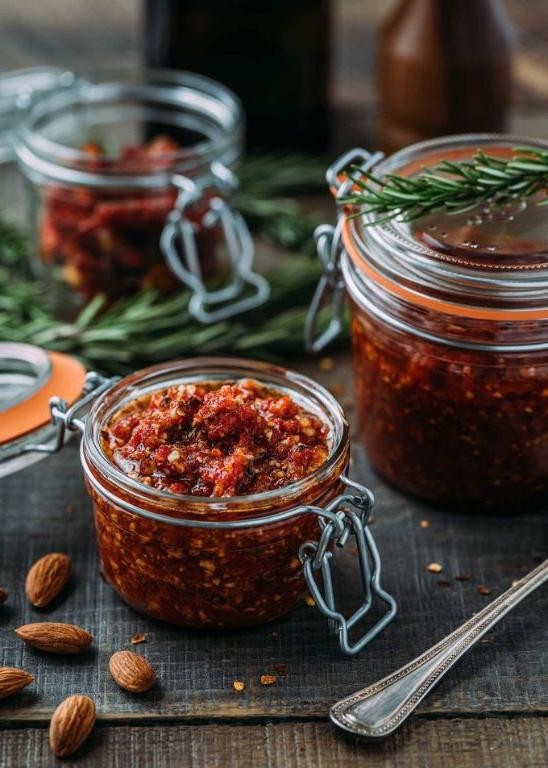
Yesterday, as the afternoon light softened across my kitchen counter, I found myself reaching for that familiar jar of sun-dried tomatoes, their deep crimson color promising the rich flavors of summer preserved. There’s something quietly comforting about transforming these concentrated gems into pesto, a process that feels both deliberate and deeply satisfying.
5
servings15
minutesIngredients
– 1 cup oil-packed sun-dried tomatoes with their fragrant oil
– ½ cup freshly grated Parmesan cheese with its nutty aroma
– ⅓ cup toasted pine nuts with golden-brown edges
– 2 garlic cloves, peeled and roughly chopped
– ¼ cup rich extra virgin olive oil
– 1 tablespoon fresh lemon juice with its bright acidity
– ½ teaspoon coarse sea salt
– ¼ teaspoon freshly cracked black pepper
Instructions
1. Drain the oil-packed sun-dried tomatoes, reserving 2 tablespoons of the flavorful oil for later use.
2. Combine the drained sun-dried tomatoes, freshly grated Parmesan cheese, toasted pine nuts, and chopped garlic cloves in your food processor bowl.
3. Pulse the mixture 8-10 times in one-second bursts until the ingredients are roughly chopped and combined.
4. With the food processor running on low speed, slowly drizzle in both the reserved sun-dried tomato oil and the rich extra virgin olive oil through the feed tube over 30 seconds.
5. Add the fresh lemon juice, coarse sea salt, and freshly cracked black pepper to the mixture.
6. Process the pesto on high speed for 45-60 seconds until it reaches a smooth, spreadable consistency, scraping down the sides once halfway through.
7. Transfer the finished pesto to an airtight container and refrigerate for at least 30 minutes to allow the flavors to meld together.
Beyond its vibrant color, this pesto offers a beautiful balance of sweet and savory notes with a pleasantly coarse texture that clings perfectly to pasta. The sun-dried tomatoes provide deep umami richness while the pine nuts add subtle crunch, making it wonderful stirred into warm orzo or spread thickly on crusty bread for a simple lunch that feels anything but ordinary.
Cilantro and Lime Pesto

Maybe it’s the way the afternoon light slants across the kitchen counter, or the quiet hum of the refrigerator, but today feels like the right moment to pause and make something bright and alive—a cilantro and lime pesto that captures the essence of fresh beginnings.
5
servings15
minutes4
minutesIngredients
– 2 cups fresh cilantro leaves and tender stems
– 1/2 cup toasted pine nuts
– 1/2 cup grated Parmesan cheese
– 2 cloves fresh garlic, minced
– 1/3 cup rich extra virgin olive oil
– 3 tablespoons freshly squeezed lime juice
– 1/2 teaspoon fine sea salt
Instructions
1. Rinse 2 cups fresh cilantro leaves and tender stems under cool water, then pat them completely dry with a clean kitchen towel to prevent a watery pesto.
2. Toast 1/2 cup pine nuts in a dry skillet over medium heat for 3–4 minutes, shaking the pan frequently, until they turn golden brown and release a nutty aroma.
3. Combine the toasted pine nuts, 1/2 cup grated Parmesan cheese, and 2 cloves minced fresh garlic in a food processor bowl.
4. Pulse the mixture 5–6 times in 1-second bursts until the ingredients are coarsely chopped.
5. Add the dried cilantro leaves and tender stems to the food processor along with 1/2 teaspoon fine sea salt.
6. Pulse again 8–10 times until the cilantro is finely chopped and evenly distributed, scraping down the sides with a spatula if needed.
7. With the food processor running on low speed, slowly drizzle in 1/3 cup rich extra virgin olive oil through the feed tube over 20–30 seconds until the oil is fully incorporated.
8. Stop the processor, add 3 tablespoons freshly squeezed lime juice, and pulse 3–4 times just to combine—avoid over-processing to keep the pesto vibrant green.
9. Taste and adjust seasoning if desired, though the balance of salt, citrus, and herbs should already be bright and harmonious.
Using this pesto feels like spreading sunshine—its texture is both creamy and flecked with emerald green, while the lime zings through the garlicky richness. Try it swirled into quinoa bowls, dabbed on grilled fish, or as a surprise layer in veggie wraps for a burst of herbal freshness.
Arugula and Cashew Pesto

Perhaps it’s the way the afternoon light falls across the kitchen counter, or maybe it’s the quiet hum of the refrigerator, but today feels right for making something simple yet deeply satisfying. Pulling out the peppery arugula and buttery cashews feels like opening a familiar story, one where bold flavors soften into something comforting and nourishing.
3
servings10
minutes4
minutesIngredients
– 4 cups fresh, peppery arugula leaves
– 1/2 cup raw, unsalted cashews
– 1/2 cup rich extra virgin olive oil
– 1/4 cup finely grated Parmesan cheese
– 2 cloves aromatic garlic
– 2 tablespoons freshly squeezed lemon juice
– 1/2 teaspoon flaky sea salt
Instructions
1. Place 1/2 cup raw, unsalted cashews in a dry skillet over medium heat.
2. Toast the cashews for 3-4 minutes, shaking the pan frequently, until they turn golden brown and release a nutty aroma.
3. Transfer the toasted cashews to a food processor and let them cool for 2 minutes to prevent the pesto from becoming greasy.
4. Add 4 cups fresh, peppery arugula leaves to the food processor.
5. Add 2 cloves aromatic garlic, peeled and roughly chopped.
6. Pulse the mixture 8-10 times until the ingredients are coarsely chopped, scraping down the sides with a spatula halfway through.
7. With the food processor running on low speed, slowly drizzle in 1/2 cup rich extra virgin olive oil over 30 seconds to create a smooth emulsion.
8. Add 1/4 cup finely grated Parmesan cheese and 2 tablespoons freshly squeezed lemon juice.
9. Sprinkle in 1/2 teaspoon flaky sea salt.
10. Process for another 15-20 seconds until the pesto reaches a creamy, spreadable consistency, being careful not to over-process and lose the vibrant green color.
Every time I make this, I’m struck by how the peppery bite of arugula mellows into something creamy and complex against the buttery cashews. It’s wonderful tossed with hot pasta, but I’ve also loved it spread thick on toasted bread with sliced tomatoes, where the bright green stands out against the red.
Mint and Pistachio Pesto
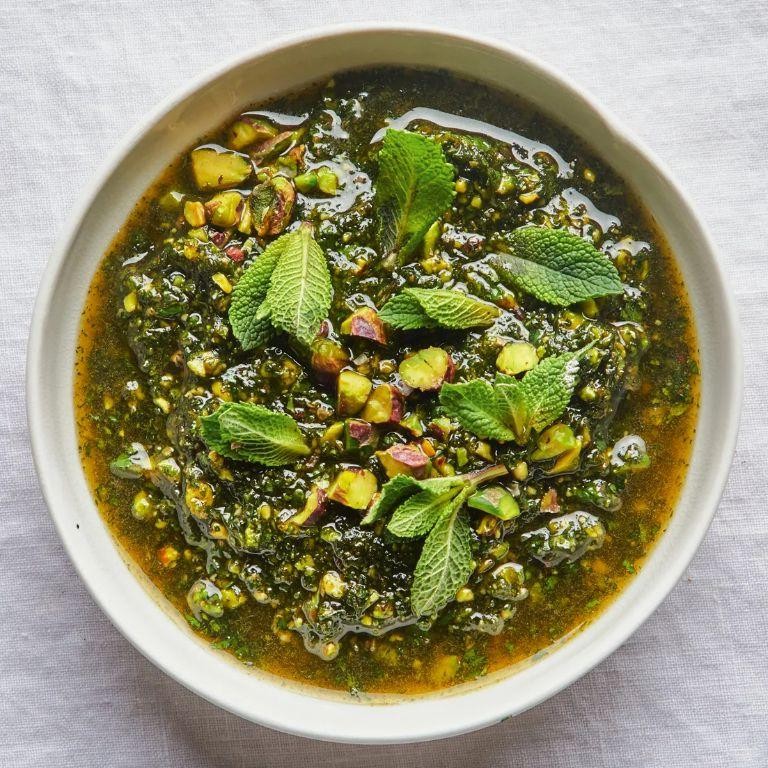
Keeping my kitchen window open today, I notice how the afternoon light catches the dust motes dancing above my cutting board, where fresh mint leaves wait patiently. There’s something quietly comforting about making pesto—the rhythmic chop of herbs, the earthy scent of nuts toasting, the way simple ingredients transform into something greater than their parts. This mint and pistachio version feels like a gentle whisper of spring, even as autumn settles in.
2
servings15
minutes4
minutesIngredients
– 2 cups fresh mint leaves, vibrant and fragrant
– 1/2 cup roasted pistachios, lightly salted and shelled
– 1/2 cup rich extra virgin olive oil
– 1/4 cup finely grated Parmesan cheese, aged and nutty
– 2 cloves fresh garlic, peeled and minced
– 1 tablespoon fresh lemon juice, bright and zesty
– 1/2 teaspoon coarse sea salt, for balancing flavors
Instructions
1. Place the roasted pistachios in a dry skillet over medium heat and toast for 3-4 minutes, shaking the pan frequently until they become fragrant and slightly golden.
2. Transfer the warm pistachios to a food processor and pulse 8-10 times until they form coarse crumbs with some texture remaining.
3. Add the vibrant mint leaves, minced garlic, and coarse sea salt to the food processor, then pulse 5-6 times until the mint is roughly chopped and incorporated.
4. With the food processor running on low speed, slowly drizzle in the rich extra virgin olive oil through the feed tube over 30 seconds until the mixture emulsifies.
5. Stop the processor and scrape down the sides with a spatula to ensure even mixing of all ingredients.
6. Add the finely grated Parmesan cheese and bright lemon juice to the mixture, then pulse 3-4 times just until combined, being careful not to over-process.
7. Taste the pesto and adjust seasoning if needed, remembering the cheese and pistachios already contribute saltiness.
8. Transfer the finished pesto to an airtight container, pressing plastic wrap directly onto the surface to prevent oxidation, and refrigerate for up to 5 days.
Creating this pesto yields a beautifully textured spread where the pistachios provide subtle crunch against the silky olive oil base. Cool mint notes dance with the Parmesan’s umami depth, making it exceptional tossed with warm pasta or spread over grilled chicken. Consider swirling it into yogurt for a vibrant dip or dolloping over roasted vegetables to elevate simple weeknight meals.
Roasted Red Pepper Pesto
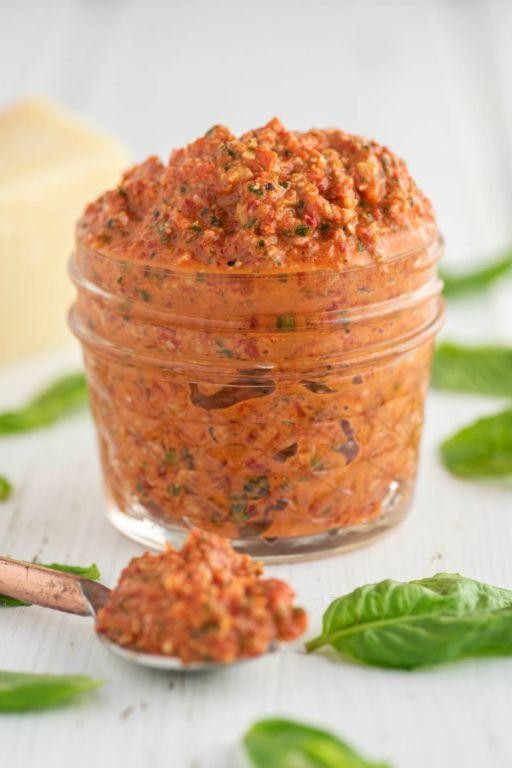
Now and then, a recipe comes along that feels like a quiet revelation, something that transforms humble ingredients into a vibrant celebration of flavor. Roasted red pepper pesto is one of those gentle discoveries, a spread that carries the warmth of the oven and the brightness of summer in every spoonful. It’s a simple pleasure, really, but one that can turn an ordinary meal into something quietly special.
3
servings25
minutes30
minutesIngredients
– 3 large, sweet red bell peppers
– 1/2 cup rich extra virgin olive oil
– 1/3 cup freshly grated Parmesan cheese
– 1/4 cup toasted pine nuts
– 2 cloves aromatic garlic, minced
– 1 tablespoon fresh, bright lemon juice
– 1/2 teaspoon flaky sea salt
– 1/4 teaspoon freshly cracked black pepper
Instructions
1. Preheat your oven to 425°F and line a baking sheet with parchment paper.
2. Cut the red bell peppers in half lengthwise, then remove the stems, seeds, and white membranes.
3. Place the pepper halves cut-side down on the prepared baking sheet.
4. Roast the peppers for 25-30 minutes until the skins are deeply blistered and charred in spots.
5. Transfer the hot peppers to a bowl and cover tightly with plastic wrap, letting them steam for 15 minutes—this makes peeling effortless.
6. Once cool enough to handle, peel away the blackened skins from the pepper flesh.
7. Combine the peeled roasted peppers, Parmesan cheese, toasted pine nuts, minced garlic, lemon juice, sea salt, and black pepper in a food processor.
8. Pulse the mixture 5-6 times until the ingredients are roughly chopped and combined.
9. With the food processor running on low, slowly drizzle in the extra virgin olive oil until the pesto becomes smooth and emulsified.
10. Scrape down the sides of the bowl with a spatula to ensure everything is fully incorporated.
Perhaps what I love most is how the pesto balances smoky sweetness from the peppers with the nutty richness of Parmesan and pine nuts. The texture is luxuriously creamy yet retains a subtle graininess that clings beautifully to pasta or crusty bread. Try swirling it into warm risotto or spreading it thickly on grilled chicken—it seems to find a home wherever it goes.
Basil and Avocado Pesto
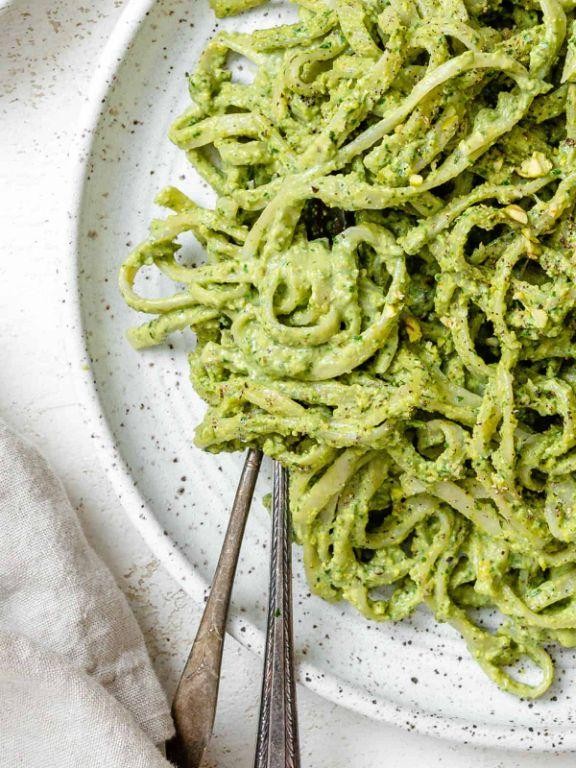
Dappled afternoon light filters through my kitchen window as I find myself craving something that feels both nourishing and nostalgic. There’s a quiet comfort in the ritual of making pesto, the steady rhythm of crushing basil and blending ingredients into something greater than their parts. This version, with its creamy avocado twist, has become my go-to when I need a meal that feels like a gentle embrace.
4
servings15
minutesIngredients
– 2 cups fresh basil leaves, fragrant and vibrant green
– 1 large ripe avocado, yielding to gentle pressure
– 1/3 cup rich extra virgin olive oil
– 1/4 cup toasted pine nuts, golden and fragrant
– 2 cloves fresh garlic, peeled and roughly chopped
– 1/4 cup freshly grated Parmesan cheese, sharp and salty
– 1 tablespoon fresh lemon juice, bright and acidic
– 1/2 teaspoon fine sea salt
– 1/4 teaspoon freshly cracked black pepper
Instructions
1. Place the toasted pine nuts and chopped garlic in your food processor bowl.
2. Pulse 5-6 times until the mixture becomes coarse crumbs, about 15 seconds total.
3. Add the fresh basil leaves to the food processor.
4. Pulse another 5-6 times until the basil is roughly chopped and incorporated.
5. Cut the ripe avocado in half, remove the pit, and scoop the flesh into the processor.
6. Add the freshly grated Parmesan cheese, fresh lemon juice, fine sea salt, and freshly cracked black pepper.
7. Begin processing on low speed while slowly drizzling in the rich extra virgin olive oil through the feed tube.
8. Increase to high speed and blend for 45-60 seconds until completely smooth and creamy.
9. Stop and scrape down the sides of the bowl with a spatula to ensure even blending.
10. Process for another 15-20 seconds until the pesto reaches a perfectly uniform consistency.
Beyond its vibrant green hue, this pesto coats pasta with a velvety richness that feels both luxurious and wholesome. The avocado lends a buttery smoothness that carries the basil’s herbal notes while the pine nuts provide subtle crunch in every other bite. I love tossing it with warm linguine or spreading it thick on crusty bread for a simple lunch that feels anything but ordinary.
Parsley and Pumpkin Seed Pesto
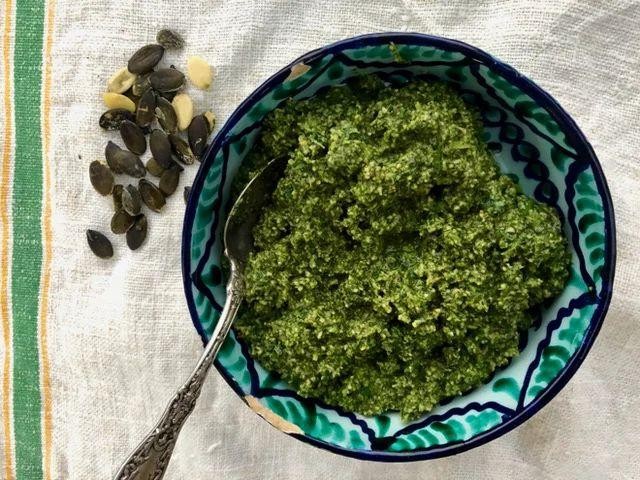
There’s something quietly magical about transforming humble ingredients into something that feels both nourishing and celebratory. Today, the gentle rhythm of chopping and blending feels like a small meditation, a way to honor the last of the season’s bright flavors before the deep quiet of winter settles in.
5
servings15
minutes7
minutesIngredients
– 2 packed cups of fresh, vibrant flat-leaf parsley leaves
– 1/2 cup of raw, green pumpkin seeds
– 1/2 cup of rich, golden extra virgin olive oil
– 1/3 cup of finely grated, salty Pecorino Romano cheese
– 2 tablespoons of freshly squeezed, bright lemon juice
– 1 small clove of aromatic, pungent garlic
– 1/4 teaspoon of flaky, crystalline sea salt
Instructions
1. Preheat your oven to 350°F to gently toast the pumpkin seeds for enhanced flavor.
2. Spread the raw pumpkin seeds in a single layer on a small, dry baking sheet.
3. Toast the seeds in the preheated oven for 5-7 minutes, until they are lightly golden and you can smell their nutty aroma, shaking the pan once halfway through.
4. Tip: Toasting unlocks the seeds’ oils, giving your pesto a deeper, more complex nuttiness.
5. Remove the baking sheet from the oven and let the toasted pumpkin seeds cool completely for about 10 minutes; warm seeds can make the pesto bitter.
6. While the seeds cool, thoroughly wash the fresh parsley and pat the leaves completely dry with clean kitchen towels or a salad spinner.
7. Tip: Ensuring your parsley is bone-dry is crucial for a vibrant green pesto that doesn’t become watery.
8. Place the cooled pumpkin seeds, dry parsley leaves, grated Pecorino Romano, peeled garlic clove, lemon juice, and sea salt into the bowl of a food processor.
9. Pulse the mixture 8-10 times in one-second bursts until the ingredients are coarsely chopped.
10. With the food processor running on low speed, slowly drizzle in the extra virgin olive oil through the feed tube over 15-20 seconds.
11. Continue processing for another 20-30 seconds, until the pesto forms a slightly coarse, textured paste.
12. Tip: Avoid over-processing; a little texture makes the pesto more interesting and prevents it from becoming a homogenous puree.
13. Scrape down the sides of the bowl with a spatula to incorporate any unblended ingredients.
14. Give the pesto one final 5-second pulse to ensure everything is perfectly combined.
Your pesto will be a beautifully textured, confetti-like spread with a brilliant green hue. The flavor is wonderfully earthy and herbaceous from the parsley, with a satisfying crunch from the seeds and a bright, salty kick from the cheese and lemon. Try it swirled into warm pasta, slathered on crusty bread, or as a vibrant topping for grilled chicken or roasted vegetables.
Zucchini and Macadamia Nut Pesto
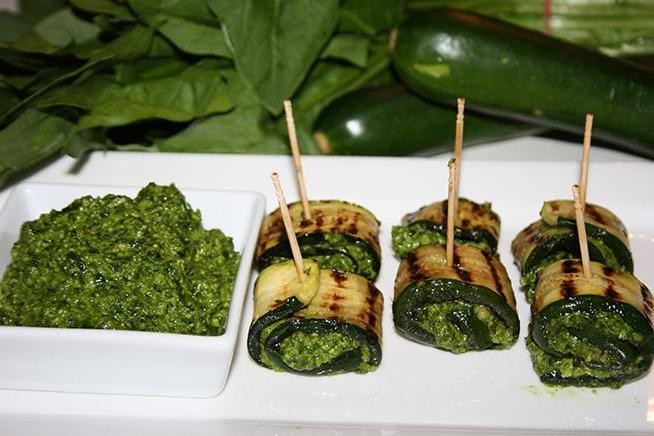
There’s something quietly magical about how summer’s most humble vegetable can transform into such vibrant comfort. This zucchini and macadamia nut pesto feels like capturing golden hour in a bowl—a gentle reminder that simple ingredients often hold the deepest flavors.
3
servings15
minutes20
minutesIngredients
– 2 medium zucchini, sliced into ¼-inch rounds
– ½ cup raw macadamia nuts, lightly toasted
– 2 cloves fresh garlic, minced
– ½ cup rich extra virgin olive oil
– ¼ cup freshly grated Parmesan cheese
– 1 tablespoon fresh lemon juice
– ½ teaspoon fine sea salt
– ¼ teaspoon freshly cracked black pepper
– 12 ounces dried linguine pasta
Instructions
1. Bring a large pot of salted water to a rolling boil over high heat.
2. While water heats, slice 2 medium zucchini into uniform ¼-inch rounds for even cooking.
3. Toast ½ cup raw macadamia nuts in a dry skillet over medium heat for 3-4 minutes, shaking frequently until golden and fragrant.
4. Add 12 ounces dried linguine to boiling water and cook for 9-11 minutes until al dente, stirring occasionally to prevent sticking.
5. Meanwhile, heat 2 tablespoons olive oil in a large skillet over medium heat until shimmering.
6. Add zucchini rounds in a single layer and cook for 4-5 minutes per side until tender with golden edges.
7. Transfer cooked zucchini, toasted macadamia nuts, and 2 minced garlic cloves to a food processor.
8. Pulse 5-6 times until coarsely chopped, scraping down sides with a spatula.
9. With processor running, slowly drizzle in remaining 6 tablespoons olive oil until emulsified.
10. Add ¼ cup Parmesan cheese, 1 tablespoon lemon juice, ½ teaspoon salt, and ¼ teaspoon pepper, then process until smooth.
11. Reserve ½ cup pasta water before draining linguine.
12. Return drained pasta to warm pot and toss with pesto, adding reserved pasta water 1 tablespoon at a time until sauce coats noodles evenly.
13. Divide among bowls and serve immediately.
Only the creamy texture from the zucchini and the buttery crunch of macadamias make this pesto feel both luxurious and wholesome. I love it tossed with linguine, but it would be equally beautiful swirled through risotto or spread on crusty bread for a simple crostini.
Pea and Feta Pesto

Lately, I’ve found myself craving something that bridges the gap between the fresh bite of spring and the comforting richness we all seek as the evenings grow cooler. This pea and feta pesto is that quiet, satisfying answer, a spread that feels both vibrant and deeply soothing.
5
servings10
minutes3
minutesIngredients
– 2 cups of frozen sweet peas
– 1/2 cup of crumbly, salty feta cheese
– 1/3 cup of rich extra virgin olive oil
– 1/4 cup of toasted pine nuts
– 1 small clove of fragrant, fresh garlic
– The juice from half a plump, juicy lemon
– 1/4 teaspoon of fine sea salt
Instructions
1. Place 2 cups of frozen sweet peas into a heat-proof bowl.
2. Pour just-boiled water over the peas until they are fully submerged, and let them sit for 3 minutes to thaw and warm through.
3. Drain the peas thoroughly in a colander, then gently pat them dry with a clean kitchen towel to remove excess moisture for a thicker pesto.
4. Combine the warmed peas, 1/2 cup of crumbly feta cheese, 1/4 cup of toasted pine nuts, 1 small clove of fresh garlic, and 1/4 teaspoon of fine sea salt in the bowl of a food processor.
5. Pulse the mixture 8-10 times until the ingredients are coarsely chopped and combined.
6. With the food processor running on low speed, slowly drizzle in 1/3 cup of rich extra virgin olive oil through the feed tube until the pesto emulsifies and becomes creamy.
7. Stop the processor, scrape down the sides with a spatula to incorporate any stray bits, and add the juice from half a lemon.
8. Pulse 3-4 more times just until the lemon juice is fully incorporated, being careful not to over-process and warm the pesto.
9. Taste the pesto and adjust with an extra pinch of salt only if needed, as the feta provides significant salinity.
For a wonderfully creamy texture, spread it thickly on toasted sourdough or toss it with hot pasta for a quick, vibrant sauce that clings beautifully to every strand.
Lemon and Parsley Pesto
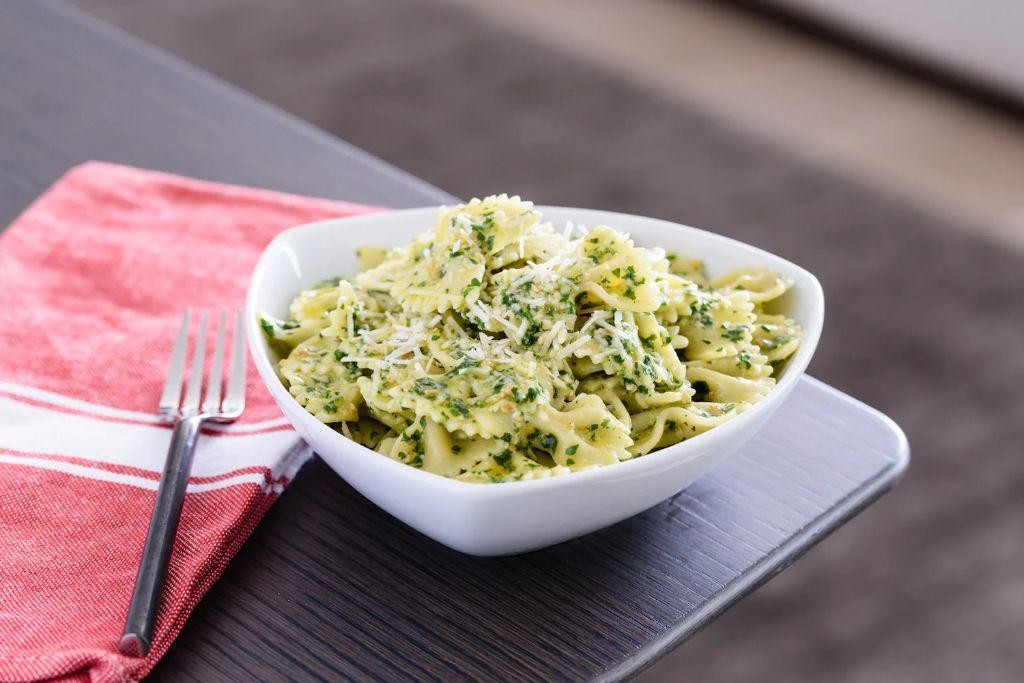
Beneath the gentle hum of the kitchen light, there’s a quiet comfort in preparing something that feels both fresh and familiar. This lemon and parsley pesto comes together like a soft, green whisper, brightening even the simplest meals with its vibrant character. It’s a small ritual that turns everyday ingredients into a little jar of sunshine.
4
servings15
minutesIngredients
– 2 cups of fresh, flat-leaf parsley leaves, loosely packed
– ½ cup of rich extra virgin olive oil
– ⅓ cup of toasted pine nuts, lightly golden and fragrant
– ¼ cup of freshly grated Parmesan cheese, finely shredded
– 2 cloves of fresh garlic, peeled and roughly chopped
– Zest and juice of 1 large, bright lemon
– ½ teaspoon of coarse sea salt
– ¼ teaspoon of freshly cracked black pepper
Instructions
1. Place the fresh, flat-leaf parsley leaves, toasted pine nuts, freshly grated Parmesan cheese, and roughly chopped garlic cloves into the bowl of a food processor.
2. Pulse the mixture 8–10 times in 1-second bursts until the ingredients are coarsely chopped, scraping down the sides of the bowl once with a spatula to ensure even mixing.
3. Add the zest and juice of 1 large lemon, coarse sea salt, and freshly cracked black pepper to the food processor bowl.
4. With the food processor running on low speed, slowly drizzle in the rich extra virgin olive oil through the feed tube over 20–30 seconds until the pesto emulsifies into a slightly textured, vibrant green paste. Tip: For a smoother pesto, process a little longer; for more texture, pulse briefly.
5. Taste the pesto and adjust seasoning if needed, remembering that flavors will meld as it rests. Tip: If the pesto is too thick, add another tablespoon of olive oil and pulse to combine.
6. Transfer the finished pesto to an airtight glass jar, pressing down gently to remove any air pockets. Tip: Pour a thin layer of olive oil over the surface before sealing to help preserve its bright color and freshness.
Glistening with flecks of green and golden nuts, this pesto carries a lively, herbaceous flavor lifted by the lemon’s gentle acidity. Toss it with warm pasta, spread it over grilled chicken, or swirl it into a bowl of creamy soup for an instant burst of freshness that feels both rustic and refined.
Carrot Top and Hazelnut Pesto

Evenings like this, when the kitchen glows with golden hour light, I find myself drawn to recipes that transform humble ingredients into something quietly extraordinary. There’s a particular satisfaction in rescuing carrot tops from the compost bin, their feathery greens holding unexpected potential for a pesto that feels both earthy and elegant.
2
servings20
minutes10
minutesIngredients
– 2 cups tightly packed fresh carrot top greens, thoroughly washed
– 1/2 cup raw hazelnuts, lightly toasted
– 2 cloves fresh garlic, peeled and smashed
– 1/2 cup rich extra virgin olive oil
– 1/4 cup finely grated Parmesan cheese
– 2 tablespoons freshly squeezed lemon juice
– 1/2 teaspoon coarse sea salt
– 1/4 teaspoon freshly cracked black pepper
Instructions
1. Preheat your oven to 350°F and spread raw hazelnuts in a single layer on a baking sheet.
2. Toast hazelnuts for 8-10 minutes until fragrant and their skins begin to crack, then transfer to a clean kitchen towel.
3. Rub the warm hazelnuts vigorously in the towel to remove most of their papery skins.
4. Pick through carrot top greens, discarding any thick stems and keeping only the tender leaves.
5. Wash carrot tops in a large bowl of cold water, swishing gently to remove all grit.
6. Spin carrot tops dry in a salad spinner or pat thoroughly with clean kitchen towels.
7. Combine toasted hazelnuts, carrot tops, garlic, Parmesan, salt, and pepper in a food processor.
8. Pulse the mixture 10-12 times until coarsely chopped, scraping down the sides with a spatula.
9. With the processor running on low, slowly drizzle in olive oil through the feed tube.
10. Continue processing for 30-45 seconds until the pesto reaches your desired consistency.
11. Add lemon juice and pulse 3-4 times to incorporate evenly.
12. Taste and adjust seasoning if needed, remembering flavors will meld as it rests.
Gently spoon the pesto into a jar, its vibrant green flecked with toasted hazelnuts and carrying the fresh, herbaceous scent of carrot tops. The texture remains pleasantly coarse, with crunchy nut pieces contrasting against the silky olive oil base. Try swirling it through roasted root vegetables or spreading it thickly on crusty bread for a lunch that tastes like the garden itself.
Broccoli and Cheddar Pesto

Zestful moments in the kitchen often arrive unexpectedly, like today when the afternoon light slants across the counter and I find myself reaching for that familiar bunch of deep green broccoli. There’s something quietly comforting about transforming humble ingredients into a vibrant, creamy pesto that feels both nourishing and indulgent, a small celebration of simplicity and flavor.
3
servings15
minutes12
minutesIngredients
– 2 cups fresh broccoli florets, chopped into small, tender pieces
– 1 cup sharp cheddar cheese, freshly grated from a firm block
– 1/2 cup raw walnuts, lightly toasted for warmth and crunch
– 1/3 cup rich extra virgin olive oil
– 2 cloves fresh garlic, peeled and finely minced
– 1/4 tsp fine sea salt, for balanced seasoning
– 1/8 tsp cracked black pepper, freshly ground for aroma
Instructions
1. Preheat your oven to 400°F and line a small baking sheet with parchment paper.
2. Spread the raw walnuts evenly on the prepared baking sheet and toast them in the preheated oven for 5–7 minutes, until they are fragrant and lightly golden—watch closely to avoid burning.
3. Bring a medium pot of water to a rolling boil over high heat, then carefully add the chopped broccoli florets.
4. Blanch the broccoli for exactly 2 minutes, until it turns bright green and is just tender but still crisp.
5. Immediately drain the broccoli and transfer it to a bowl of ice water to stop the cooking process, which helps retain its vibrant color and texture.
6. Pat the blanched broccoli completely dry with a clean kitchen towel to prevent a watery pesto.
7. In a food processor, combine the dried broccoli, toasted walnuts, freshly grated sharp cheddar cheese, finely minced garlic, fine sea salt, and cracked black pepper.
8. Pulse the mixture 5–7 times until the ingredients are coarsely chopped and evenly distributed.
9. With the food processor running on low speed, slowly drizzle in the rich extra virgin olive oil through the feed tube until the pesto becomes smooth and emulsified, scraping down the sides once if needed.
10. Transfer the pesto to a serving bowl and let it rest for 5 minutes to allow the flavors to meld together. The pesto emerges velvety and speckled with green, carrying the earthy sweetness of broccoli and the sharp, tangy depth of cheddar. Try swirling it into warm pasta or spreading it thickly on toasted sourdough for a quick, satisfying meal that feels like a gentle embrace.
Olive and Artichoke Pesto

Musing on the quiet hum of the kitchen, I find myself reaching for the jar of briny olives, their savory depth promising to transform simple ingredients into something quietly profound. This olive and artichoke pesto feels like a gentle rebellion against the expected, a way to preserve a moment of calm creativity in a bustling world.
5
servings15
minutesIngredients
– 1 cup pitted Kalamata olives, rich and briny
– 1 cup marinated artichoke hearts, tender and slightly tangy
– 1/2 cup toasted pine nuts, fragrant and golden
– 2 cloves fresh garlic, finely minced
– 1/2 cup rich extra virgin olive oil
– 1/4 cup freshly grated Parmesan cheese, sharp and salty
– 1 tbsp fresh lemon juice, bright and zesty
Instructions
1. Place the toasted pine nuts and minced garlic in the bowl of a food processor.
2. Pulse the mixture 5-7 times until the nuts are coarsely chopped, being careful not to over-process into a paste.
3. Add the pitted Kalamata olives and marinated artichoke hearts to the food processor bowl.
4. Pulse the mixture 10-12 times until the ingredients are roughly chopped but still maintain some texture.
5. With the food processor running on low speed, slowly drizzle in the rich extra virgin olive oil through the feed tube over 30 seconds.
6. Stop the processor and scrape down the sides with a rubber spatula to ensure even mixing.
7. Add the freshly grated Parmesan cheese and bright lemon juice to the mixture.
8. Pulse the food processor 5-6 times until all ingredients are just combined but still slightly chunky.
9. Transfer the pesto to an airtight container, pressing plastic wrap directly onto the surface to prevent oxidation.
Nothing compares to the way this pesto clings to pasta with its slightly chunky texture, each bite revealing the briny olives and tender artichokes in perfect harmony. Try spreading it thick on crusty bread for a simple lunch, or thin it with more olive oil to dress roasted vegetables, letting its complex flavors transform even the most humble ingredients.
Thai Basil and Peanut Pesto

Venturing into the kitchen today felt like unfolding a quiet story, one where familiar ingredients might whisper secrets from distant places. This Thai basil and peanut pesto came together like a gentle experiment, each addition revealing something new about balance and comfort.
5
servings15
minutesIngredients
– 2 cups fresh Thai basil leaves, fragrant and vibrant green
– 1/2 cup roasted unsalted peanuts, coarsely chopped
– 3 cloves garlic, peeled and smashed
– 1/4 cup fresh lime juice, bright and tangy
– 2 tablespoons soy sauce, rich and savory
– 1/4 cup extra virgin olive oil, smooth and golden
– 1 teaspoon honey, warm and floral
– 1/4 teaspoon red pepper flakes, for subtle heat
Instructions
1. Place the fragrant Thai basil leaves, coarsely chopped roasted peanuts, and smashed garlic cloves into a food processor.
2. Pulse the mixture 5–7 times until the ingredients are roughly chopped, being careful not to over-process.
3. Add the bright lime juice, rich soy sauce, smooth olive oil, warm honey, and red pepper flakes to the food processor.
4. Blend on medium speed for 30–45 seconds until the pesto is mostly smooth but retains some texture from the peanuts.
5. Taste the pesto and adjust seasoning if needed, keeping in mind the soy sauce already adds saltiness.
6. Transfer the pesto to an airtight container, pressing plastic wrap directly onto the surface to prevent browning.
7. Refrigerate for at least 30 minutes to allow the flavors to meld together beautifully.
Something about this pesto feels both grounding and exciting—the creamy peanuts mingle with the basil’s anise-like notes, while lime brightens every bite. Try it tossed with rice noodles and shredded carrots, or spread thickly on grilled chicken for a quick, aromatic dinner that tastes far more complex than its simplicity suggests.
Conclusion
Now you have 20 creative pesto recipes to transform your meals! These diverse flavors prove pesto goes far beyond basil. We hope you’ll try these delicious variations, share which ones become your favorites in the comments below, and pin this article on Pinterest to inspire fellow home cooks. Happy cooking!
